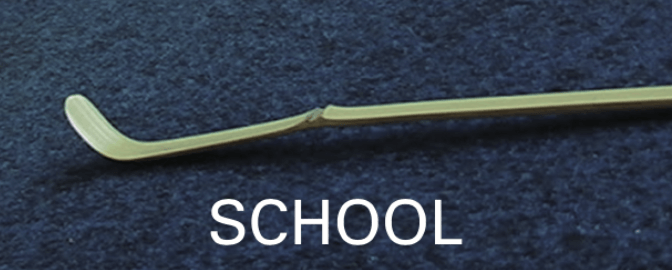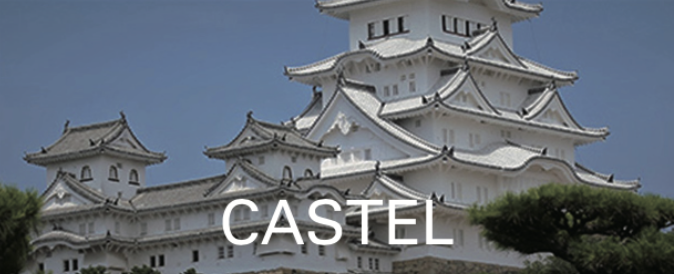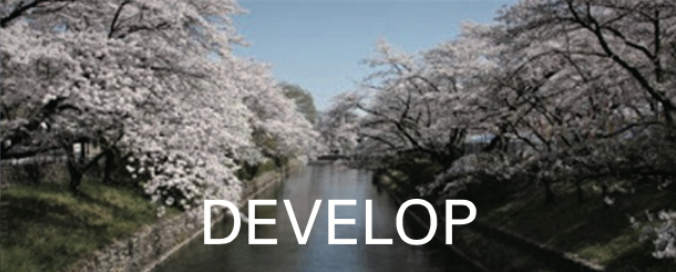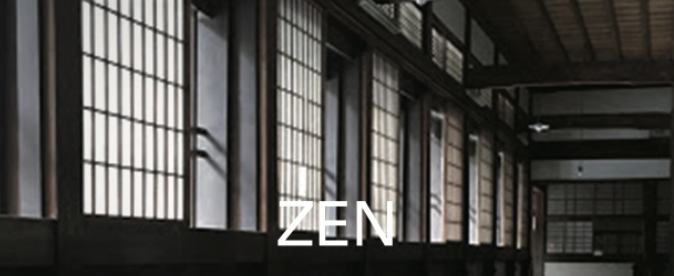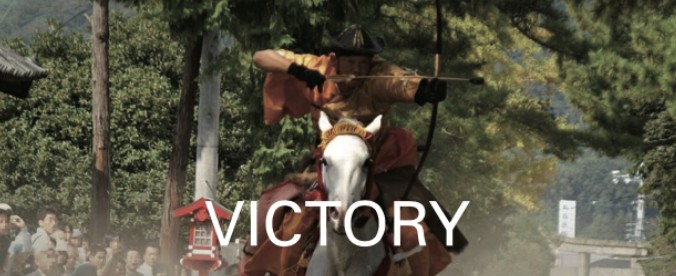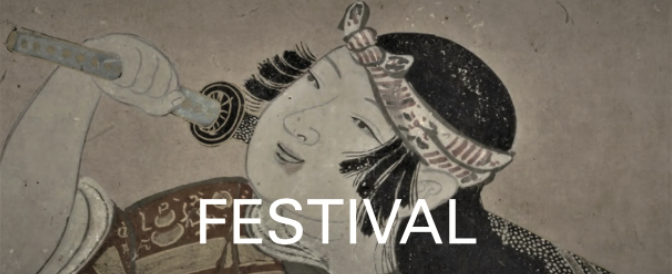
Ayabe is a place where culture has taken root since ancient times. Ashikaga Takauji (1305 – 1358), the founder of the Ashikaga Shogunate, was born in Uesugi-so Villege, Ayabe. The temple remains his maternity room and the wells for the baby’s first bath for him. This temple was the foremost head of the Ankokuji Temple and Rishou-to Pagodas to perform the salvation of a departed soul of Emperor Go-Daigo (1288 – 1339) and the emperor’s retainers, in the period of the Northern and Southern Courts (1336 – 1392).
The principle image of this temple is the sedentary statue of the Buddha triad, Buddha attended by two Bosatsus, which was made with Gyokugan, eyes made of crystal, and high quality. The decent appearance of the statue of Buddha is characteristic of the Kamakura period (1185 – 1333).
It is a masterpiece engraved by a Japanese sculptor of Buddhist statues, Goen of Enpa, En school for sculpturing Buddhist images, in 1341.
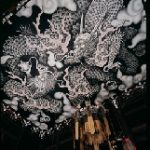
This temple was founded in 1202 by Eisai Zenji (1141 – 1215), a Japanese Buddhist priest, who brought Rinzai Zen to Japan, with the support of Minamoto no Yoriie, (1182 – 1204) the 2nd shogun of the Kamakura Shogunate.
This temple was founded during the Kenni era in Japan. Therefore, the era name became this temple name. This temple is the third rank of Kyoto Gozan, the five great Rinzai temples of Kyoto.
This temple possesses rich cultural properties. Included are: the National Treasure, Fujin Raijin-zu byobu, the folding screens of the Wind God and Thunder God, by Tawaraya Sotatsu (1570? – 1640?) a Japanese painter and designer of the Rinpa school, Fusumae, a picture painted on a sliding paper door, and the sliding screen paintings by Kaihou Yusho (1533 – 1615), a Japanese painter.
In 2002, in honor of Kenninji Temple’s 800th anniversary, an image of two dragons was painted on the ceiling of this lecture hall by Koizumi Junsaku (1924 – 2012), a Japanese painter from Kamakura.
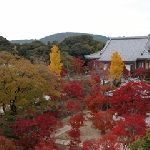
This temple is the head temple of a Buddhist Shingon sect Chisan school, which was a sub-temple of Negorodera Temple in Kishu Wakayama, and prospered as Gakumonojo, prestigious school. Negorodera Temple was burned down by Toyotomi Hideyoshi (1537 – 1598), the powerful feudal lord and Imperial Regent who unified Japan.
Genyu Sojo (1529 – 1605), a Gakuto, scholarly chief of the sect, escaped to Kyoto and revived Chishakuin Temple and became head priest of this temple. Hideyoshi built Shounzenji Temple to perform religious rites for the salvation of the departed soul of his son, Turumatsu, (1589 – 1591).
After some time passed, Tokugawa Ieyasu (1543 – 1616), the founder of the Tokugawa Shogunate, donated the Shounzenji Temple to Sojo. That donation included splendid and elaborate wall paintings, with brightly colored, gold leaves. These were Kaede-zu (Maple Tree painting), and Sakurazu-zu (Cherry Blossom painting) by Hasegawa Tohaku (1539 – 1610): founder of the Hasegawa school, and his son, Hasegawa Kyuzo (1568 – 1593).

This museum introduces the history of the development and maintenance of Akechi Mitsuhide (1528 – 1582) a feudal lord and general under Oda Nobunaga (1534 – 1582), the legendary warlord and the military dictator, and raised in rebellion against Nobunaga in 1582, from the early modern times.
The Fukuchiyama basin flourished as a key point of transportation connecting the Japan Sea and Nara and Kyoto, by Yura River to make a detour as a dragon to Wakasa Bay from Mt.Mikunidake, at the Prefecture border of Kyoto, Shiga and Fukui.
In the 16th century, Mitsuhide built the castle called Garyujo Castle, lying dragon castle, in the hillock to stick out to the center of the basin, where ancient settlement sites were, and he developed a castle town.
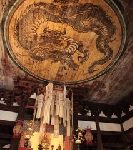
The lecture hall of a temple is the most important in the complex of Zen temple buildings, where a chief priest of the temple guides the essence of Buddhism. The lecture hall of this temple was built in 1605 by Toyotomi Hideyori (1593 – 1615), the son of Toyotomi Hideyoshi (1537 – 1598), the powerful feudal lord and Imperial Regent who unified Japan, and is the oldest and largest lecture hall of a temple in Japan.
This hall was protected in the great fire of 1788, by Nakiryu, a roar of the rising dragon, which is one of Eight Guardians of Buddhism, and was painted on the ceiling. Nakiryu, means flutter echo which is a vibrations caused by clapping hands at the center of the hall with the hidden structure between the floor and ceiling. Nakiryu was painted by Kanou Mitsunobu (1565 – 1608), the eldest son of Kanou Eitoku, whose paintings were intelligent and peaceful.
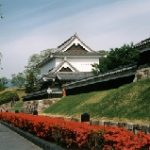
The sites of Shoryuji Castle became a Park with an exhibition room, Yagura, turret and a garden after the investigation of the historic site. Hosokawa Fujitaka Yusai (1534 – 1610) was appointed by Oda Nobunaga (1534 – 1582), the legendary warlord and the military dictator, to be the lord of Shoryuji Castle.
He was a retainer of the Last Ashikaga shogunate and became a feudal lord under Oda Nobunaga (1534 – 1582). His son, Hosokawa Tadaoki (1563 – 1646), a feudal lord, the eldest son of Hosokawa Fujitaka Yusai, had a wedding ceremony at this castle with Tama Garasha (1563 – 1600), who was the daughter of Akechi Mitsuhide (1528 – 1582) a feudal lord, a general under Oda Nobunaga (1534 – 1582), the legendary warlord and the military dictator, and raised in rebellion against Nobunaga in 1582.
The decisive battle between Mitsuhide and Toyotomi Hideyoshi (1537 – 1598), the powerful feudal lord and Imperial Regent who unified Japan, took place in Yamazaki near this castle. Yusai who declined Mitsuhide’s call for reinforcements, shaved his head and become a Buddhist priest, handed over their family estate to Tadaoki, and left this castle. Tama was divorced and imprisoned. She became a Christian convert.
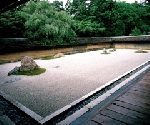
This temple was established by Hosokawa Katsumoto (1430 – 1473), the deputy to the Ashikaga Shogunate, in 1450. Giten Gensho was invited as the first chief priest, who was at the time the fifth abbot of Myoushiji temple.
There is the Zen rock garden of white sand, with a width of 25 meters and a depth of 10 meters. It has sand prints, and has 15 stones interspersed. The meaning of this rock garden symbolized that the extreme is mysterious and depends on the free interpretation of the viewer.
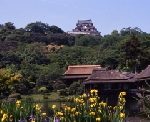
This garden adjacent to Hikonejo Castle and borrowing its views was landscaped by Ii Naooki (1656 – 1717) a feudal lord, the 4th -9th lord of the Hikone Domain, in 1677. This name came from the garden of Chinese court. There is a large pond imitating Lake Biwa to have Omi Hakkei, Eight Views of Omi, which had been associated with the Views of Dongting Hu, China. Rintchikaku, the style of a tea-ceremony arbor stands out from the pond. Housoudai, is Kyakuden, the reception hall with an intentionally contrived design on the Chikuzan, an artificial hill.
This garden of beauty overlaps in multiple layers, like the concepts of Taoist immortality in the scenery, and the scene of Pure Land in the traditional Zen-style architecture. Aware, sorrow of aristocrats and Apare, admirable of samurai play together in the beauty scenes.
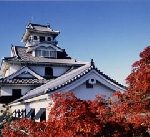
Asai clan, a feudal of Nagahama, formerly named Imahama was ruined in 1573. Toyotomi Hideyoshi (1537 – 1598), the powerful feudal lord and Imperial Regent who unified Japan, changed the name of Imahama to Nagahama, in order to show respect to Oda Nobunaga (1534 – 1582), the legendary warlord and the military dictator.
Nagahama was an important transportation hub and Hideyoshi had his first castle, Nagahajo Castle, here. He built this castle by carrying lumber from Chikubushima Island, the island where God resides, located in front of Nagahama. This museum introduces the history of northern Lake Biwa and Nagahama, which has continued since the Jomon period (16,000 years ago – 3,000 years ago).
You can overlook the philosophy of Pure Land and the rich aesthetic sense inherited by Omi shonin, the merchants of Omi Province, Shiga, who emerged all over Japan in the early modern time.
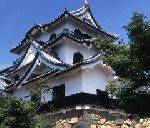
Hikonejo Castle never fought, and the castle tower was a symbol of the Hikone Domain, looking up from the castle town rather than being used by the feudal lord. And “Hikonyan – a white cat wearing a war helmet” is the character of this national treasure. The Hikonejo castle construction 400 years festival, has a model of a white cat related to Ii Naotaka (1590 – 1659), the 2nd lord of Hikone Domain Omi Province.
The war helmet of “Hikonyan” comes from the red war helmet handed down by the Ii family, of which only red-colored arms and armor were used.
The culture of the Iie family,the feudal lord of Hikone Domain was also revived at the festival and are introduced at Hikonejo Castle Museum.
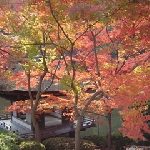
This castle boasting its majestic figure in the high view of the Mt. Trafusuyama is a National Treasure.This castle was built by Toyotomi Hidenaga (1541 – 1591), a feudal
lord and the younger brother of Toyotomi Hideyoshi, a powerful feudal lord and Imperial Regent, who unified Japan.
Later, Tokugawa Yorinobu (1602 – 1671) entered this castle as feudal lord. Yorinobu was a feudal lord, the founder of the Kishu Tokugawa clan, and was the tenth son of Tokugawa Ieyasu (1543 – 1616), the founder of the Tokugawa Shogunate.
After that, this castle had the most important position in the western part of Japan. In the northwest foot of the castle, there is the Momijidani, Maple-valley, garden, built by Yorinobu. He designed the pond to have two stages and waterfalls, by using sloping land, and set an arbor by a lake, named Engyokukaku at the inner moat.
It was a rare example to build a garden with a tea-ceremony room and an arbor, within the wall of a castle.
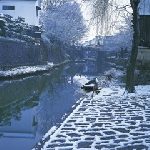
Toyotomi Hidetsugu (1568 – 1595), the Imperial Regent and the nephew of Toyotomi Hideyoshi (1537 – 1598), the powerful feudal lord and Imperial Regent who unified Japan, built the castle to relocate a part of the abandoned castle of Azuchijo Castle, and developed the castle town, in 1585.
Although the castle was abandoned in 10 years, the reed screen of Omi, Shiga, made of the lakeside reeds, and the Omi shonin, merchants of Omi Province remain and have expanded.
A peaceful boat tour in the riverside district still contains the sound of the wind swaying bunches of reeds. It is a refreshing breeze over the water surface, with the narrative of the boatman.
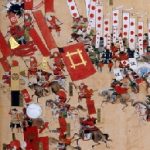
The museum introduces valuable cultural properties and materials transmitted to the Ii family, the lords of Hikone Domain. Hikone Byoubu, Hikone folding screen, is a masterpiece of the early modern genre of Fuzokuzu, the painting of manners and customs, at the beginning of early modern time.
It is presumed that it was produced in the Kanei era(1624~44) in the Edo period and that the motif was the Yuri, the red light district in Kyoto at that time. Each person was drawn to show the intimate relationship, by posing with mountain folds and valley folds of the folding screen form. That composition was well calculated. The line drawings and colors of the hair stitches and costume patterns were extremely refined.
The picture-in-picture resembled Kinkishoga, the Four Elegant Pastimes, (Harp, Chess, Calligraphy and Painting) in Kanga, Chinese style painting.
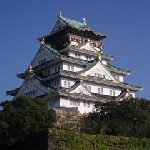
This castle is located at the northern end of the Uemachi plateau, where the ancient the Naniwa no Miya, Naniwa Palace was located, and is built on the site of Osaka (Ishiyama) Honganji temple, which was developed from the hermitage and the vihara of Rennyo (1415 – 1499) a head-priest of the Honganji temple, and descendant of Shinran (1173 – 1263) who was the founder of the Jodo Shinshu.
This castle was built by Toyotomi Hideyoshi (1537 – 1598), the powerful feudal lord and Imperial Regent who unified Japan. This museum exhibits items associated with Hideyoshi, materials related to the Age of Provincial Wars in the 15th – 16th centuries and Osakajo Castle, including a full-size reconstructed model of the golden tea room, and others.
– The castle used to have a black-lacquered siding structure, like Azuchijo Castle, instead of white walls.
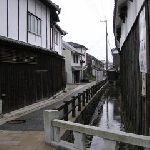
Tatsunojo Castle is a restored Honmaru Palace, the keep of a castle Palace, at the foot of the mountain. It was rebuilt by Wakisaka Yasumasa (1633 – 1694), a feudal lord, in the early Edo period. The castle town is called Little Kyoto, and the samurai residences, and merchant houses and Teramachi, Temple town, retain their old-days atmosphere.
Although Yasumasa was adopted and the 3rd lord of the Wakisaka family, he inherited the technology of building castles and developing a castle town from those family members before him. Wakisaka Yasuharu (1554 – 1626), the 1st head of Wakisaka family as a feudal lord of Tatsuno Domain, used these skills at Ozu Domain, Ehime in the Iyo Hijikawa River.
Wakisaka Yasumoto (1584 – 1654): the 2nd head of the Wakisaka family as a feudal lord of Tatsuno Domain used these at Omi Province Shiga, and at Iida Domain, Nagano in the Shinano Tenryugawa River. And Yasumasa left the beauty intelligence from appreciating the land.
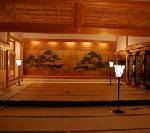
Sasayamajo Castle, was built on the important position of Sanindo, the northwest region of Honshu Island and the main road running through it. It was built by Tokugawa Ieyasu (1543 – 1616), the founder of the Tokugawa Shogunate. Daishoin, a large drawing room of this castle used to be comparable in size and decoration to the Kyoto Nijojo Castle in Kyoto capital, the large drawing room in the great hall of Ninomaru Palace, which was built around the same time.
In Daishoin, restored in 2000, a painting on a folding screen drawn by a painter of the Kanou School is used as a wall painting and reproduces the time and space. Daishoin was a drawing room and represented Kuroshoin, private residential quarters, Shiroshoin, the drawing room of Edojo Castle of Shogun in Tokyo.
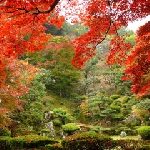
This temple is the family temple of Sasaki Kyogoku clan, which was a descendant of Omi-Genji (Minamoto clan) from Emperor Uda (867 – 931). This temple was built in 1283 by Kyogoku Ujinobu (1220 – 1295), the founder of the Kyogoku clan. 34 Hokyoin-to, a Buddhist pagoda used as a tomb and memorial tower are spectacular, each of which spans from Ujinobu to generations, as centered Kyogoku Takatsugu (1560 – 1609), a Japanese feudal lord, and the 19th head of the Kyogoku clan, who married Hatsu Hime, Jokoin, one of three daughters of Asai Nagamasa (1545 – 1573), a Japanese feudal lord.
The garden is a typical early Edo style with a pair of waterfalls, resembling the landscape of Mt. Kiyotaki of Shatsukei. It was said to be made by Kobori Enshua (1579 – 1647), a feudal lord, a master of the tea ceremony, an architect and garden designer. The taste of the garden changes greatly in the four seasons, and the expression changes in the morning, afternoon, and evening.

This temple is the branch temple of Daitokuji Temple in Kyoto, which was restored by Takuan Zenji (1573 – 1645), a major figure in the Rinzai school of Zen. This temple is located by Kinosaki Onsen, hot spring, which is close to Izuchi Town, the hometown of Takuan.
This temple has a stone garden, “Seikan-tei”. The garden is Karesansui, dry landscape garden and the famous water from Kinosaki Onsen, developed during the Nara period (710 – 794), springs out. The water is called the water of Dokko, which means Gilt-bronze Single-pronged Vajra, a weapon used as a ritual object to symbolize indestructibility and irresistible force.
Takuan guided Kenzen ichimi, Swordsmanship and Zen are one and the same, of Fudochi Shinmyo Roku, the miracle Immovable Wisdom, to Yagyu Munenori (1571 – 1646), a feudal lord and swordsman. Munemori, was an instructor of martial arts to the Tokugawa Shogun family.
You will encounter the Swordsmanship of Yagyu, which keeps unconscious and allows you to watch various movements without being caught.
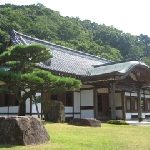
The castle on a hill in the plains of Tatsunojo Castle was rebuilt by Wakisaka Yasumasa (1633 – 1694), a feudal lord, in the early Edo period. Wakisaka was the lord of this castle in the Edo period. Now Honmaru Palace, the keep of a castle Palace was restored. The Wakisaka family was originally from Omi, Shiga Asai. The family served the Asai clan and Hashiba Hideyoshi (Toyotomi Hideyoshi (1537 – 1598), the powerful feudal lord and Imperial Regent who unified Japan, in Nagahama Shiga.
Therefore, the Wakisaka family knew well that modern castles developed with the basic layout of castle town. This castle town is called little Kyoto capital in Harima province. The elegance of the tea-ceremony room, Shuentei in the Wakisaka Family House at the Tatsuno Park, also shows the history of the Wakisaka Family.

This shrine is Harimanokuni Sosha, deducted to several gods in Harima Province, which is an old shrine and is located at the inside of the former Himeji Castle. Enshrined here are Itate Okami, Isotakeru, the eldest son of Susano no mikoto, the powerful god in Japanese mythology and the God of planting trees. Hyozuno Okami, Onamuchi no kami, Okuninushi no kami, the son-in-law of Susano-no-Mikoto, the younger brother of Amaterasu Oomikami: Sun Goddess and mythical ancestress of the Japanese imperial line, and a local deity linked with the harvest and agriculture, and the ruler of Izumo Province, the God of building nations.
This shrine had been devoutly worshiped by the successive lords of Himejijo Castle. Himejijo Castle was built at Himejioka, where Divine servants lived and where the Himeyama virgin forest was. The enshrinement of Harimanokuni Sosha in Himejijo Castle made it the authentic center of Harima Province.
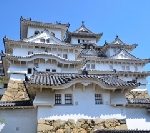
Himejijo Castle was built by Ikeda Terumasa (1565 – 1613), a feudal lord in the early Edo period. This castle was built at Himejioka, where Himeko, the silkworm settled down from the wrecked God ship, according to Harimanokuni, Harima Province Fudoki, description of Japanese regional climate, culture, and others.
This castle has a castle structure of triple helix and labyrinthine aisles. This castle tower was designed with a high variation of wide and narrow corridors.
The Himeyama virgin forest is natural vegitation at the inner moat, northeast of Honmaru, the keep of a castle to the southern end of Nishimaru, the western citadel. It is a unity of culture and function.

The history of the great castles of Azuchijo Castle and Osakajo Castle had been inherited by Himeji Castle, which was the supervising base of the Western Provinces.
This museum is adjacent to the castle and exhibits the cultural value of the castle town, which was integrated with the castle.
The value of the early modern castle is based on the functionality of the castle town’s basic layout, the formation of the landscape, such as Himeyama virgin forest, and its awe-inspiring history. The castle tower symbolizes it all.
– The early modern castles in Japan were the tool to prevent War.
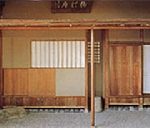
This museum is at the ruins of Toyamajo Castle, which was built in the Age of the Provincial Wars in the 15th – 16th centuries and flourished as a castle of feudal lord, the Toyama Maeda family, during the Edo period (1603 – 1868). This museum exhibits a collection of the oriental antique arts, which are mainly paintings and ceramics.
In addition, Ryuteian, a tea-ceremony room, created under the guidance of Kanamori Sowa (1584 – 1657), a master of the tea ceremony and garden designer, was relocated here. The room has Nijyo Dai, two Tatami mats, for the main guest, double sliding wooden doors of Nijiriguchi, a small door that leads into the tea ceremony room. Its long and narrow alcove has Fumikomi-doko, floor boards, and Bokuseki Mado, a window on the side wall to provide light.
This style has a fashionable aesthetic, which was Hime Sowa, the tea ceremony style loved by the court nobles in Kyoto.
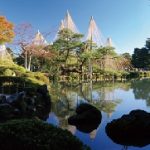
Ishikawa Kenrokuen is one of the three most beautiful gardens in Japan, as well as Mito Kairakuen and Okayama Korakuen. Its theme is the Taoist immortality. Maeda Tunanori (1643 – 1724), the 5th lord of Kaga Domain made this garden in the 17th century, and made 3 islands in the calabash shaped pond, Hisagoike, to resemble immortality islands, Hourai, Houjyou and Eishu, where the Taoists live.
He bridged the innocent nature’s thoughts on longevity, which originated in Chinese Taoism, and the prosperity thoughts of his descendants from Confucianism.This garden represents beauty that doubles as the idea of conflict.
– There are also October cherry blossoms, too. They make flowers bloom intermittently, with a pale red color.
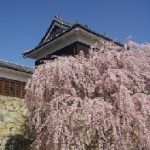
Uedajo Castle Park is surrounded by flowers and greens, with the 100-year-old row of Keyaki, Japanese zelkova. The castle of a feudal lord, Sanada clan stands still in the park. This castle was built in the center of the Ueda basin by Sanada Masayuki (1547 -1611) a feudal lord and a vassal of the Takeda clan, during the Azuchi-Momoyama period (1573 – 1603). This castle has the history of twice defeating the attacks of large armies of the Tokugawa clan, with limited military force.
The castle ruins mainly composed of defense moats and earthworks, and works associated with the Sanada clan, introduced at the Ueda City Museum in the castle, tell us about the Sanada insight to master rationality.
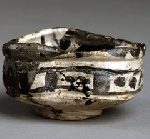
Oribe ware has rampant painting, bold modeling, and innovative design. The history of Mino ware, the precursor of Oribe ware, started from Sue ware, unglazed earthenware in the first part of the 7th century. Motoyashiki kiln, produced many tea bowls, during the rise of the tea ceremony in Sakai. Osaka and Kyoto, from the Azuchi-Momoyama period (1573 – 1603) to the early of Edo period (16th-17th century).
This museum introduces many potteries that tell the history of Mino ware through special exhibitions once a year and several special exhibitions, focusing on Shino ware and Oribe ware, excavated from the ruins of Motoyashiki kiln, which produced famous pottery.

The Echizen coast has a variety of quay walls formed by the rough seas, and there are many legends such as Kameshima, where turtles have become rocks, and the footprints of God who helped people from drought. Fukui was ruled by the Tatsudaira lord family in the Edo period (1603 – 1868). They were relatives of the Tokugawa Shogun family.
This garden near the north of the keep of Fukuijo Castles remains. It was built by the founder of this Domain, Yuki Hideyasu (1574 – 1607) who was the 2nd son of Tokugawa Ieyasu (1543 – 1616), the founder of the Tokugawa Shogunate.
It was called Osensui Yashiki, a town house villa built for the lords of Fukui Domain. It is a famous garden where the view from the boat and the villa was carefully considered.

This museum exhibits a number of Daimyodougu, Japanese feudal lord’s belongings, handed down to the Owari Tokugawa family. The armor was worn by Tokugawa Ieyasu (1543 – 1616), the founder of the Tokugawa Shogunate.
The helmet is shaped like a water-buffalo horn. The armor was implanted with bear’s hair. It’s string and leather were connected with black thread. The whole body is black and the beaver is crimson, which vividly stands out.
This armor design is eccentric and clearly shows the characteristics of Tosei Gusoku, the armor of the style in the Age of Provincial Wars in the 15th – 16th centuries. It is made of large plates, especially compared with earlier armors.
This was the important relics of Ieyasu, which was laid in a special place in the small castle tower of Nagoyajo Castle in the Edo period (1603 – 1868).
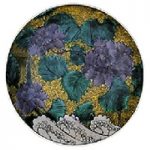
The Aode style of Kutani Pottery uses a deep green and yellow as basic colors, adding bitumen and purple. Both the front and back of the Pottery are hand painted. It encourages drawing with an open-mind and audacious touch.
This museum is located in Kokutani no mori, the Daishoji Fureai Park in Kaga City, and introduces its works by style, including Aode style, Iroe Gosaide, and Akae Kinrande.
There are presentations about techniques of the traditional Kutani style, which used to be made in Kutani Village of Daishoji Domain during the Edo period (1603 – 1868).
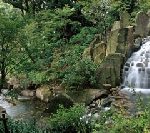
Nagoya Castle was built at the ruins of the castle Nakoya, where Oda Nobunaga (1534 – 1582), the legendary warlord and the military dictator, was born.
Shogun Tokugawa Ieyasu (1543 – 1616), the founder of the Tokugawa Shogunate, built Nagoyajo Castle tower by carrying rafts of cypresses from Kiso mountain to Kuwana, Nagoya. He built a castle tower, using an unprecedented layering approach, having both a detailed design and stability.
Tokugawaen is a daimyo garden, a garden style that features a path around a pond. This garden used to belong to the Ozone residence, the retired house of Tokugawa Mitsutomo, the 2nd lord of Nagoyajo Castle.
This garden resembles the Kiso River, which flows from Mt. Ontake to Ise bay, by making use of the height difference of the land.
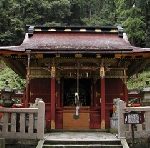
This shrine is located at Mt. Houraijisan (684m). This Toshogu shrine used to be in the Shogun‘s Edo castle. Tokugawa Iemitsu, the third shogun (1604 – 1651), moved the shrine, when he founded this location. This shrine was built to show gratitude to Tokugawa Ieyasu (1543 – 1616), the founder of the Tokugawa Shogunate.
The name of Mt. Houraijisan came from Horijisan temple, which was founded by Rishu Sennin, an ascetic during the 6th century who carved Yakushi Nyorai, the Buddha of Healing, out of seven, sacred cedar trees. In 703, Emperor Mommu (683 – 707) built the temple, and named it as Houraiji temple for the gratitude of recovering from his illness.
An 800-year-old cedar stands over the mountain gate and the Nio mon, a Deva gate, which were built by Minamoto no Yoritomo (1147 – 1199), the 1st shogun of the Kamakura Shogunate.

Toyamajo Castle was built during the Age of Provincial Wars in the 15th – 16th centuries, and flourished as the castle of feudal lord of the Toyama Maeda family during the Edo period (1603 – 1868). Another name of this castle was Ukijo, a floating castle, which has the moat drawn water from Jinzu River. The moat surrounded all sides, and made it a solid castle. This castle was one of castle model of the Song, The Moon over the Ruined Castle sings a cherry-blossom-viewing feast on the castle tower in the spring.
The museum introduces the castle history of 400 years, and Sato Memorial Museum of Art exhibits a collection of paintings and ceramics, mainly oriental antique arts.

The area of Minami-Uonuma used to be called Ueda no sho, Village. It is the start of the Mt. Makihatayama trail, covered with rich alpine plant and virgin forest. Mt. Makihatayama is listed as one of the 100 most famous mountains in Japan. Naoe Kanetsugu (1559–1620) was a senior retainer of the Uesugi clan, and served Uesugi Kenshin (1530 – 1578), the feudal lord of Echigo Province and his nephew, Uesugi Kagekatsu. Kanetsugu grew up in this temple of the Soto school of Zen at Ueda no sho.
This temple was built during the Nara period (710 – 794), and was restored by the Uesugi family, who was Kanto Kanrei, a shogunal deputy for the Kanto region, in the Muromachi Period (1366 – 1573). Both Uesugi Kenshin and Takeda Shingen (1521 – 1573), the feudal lord of Kai Province, studied under Hoko Zenshuku Osho, the 10th head priest of this temple. The two also fought each other.
That relation made ”Tekini Shio wo okuru – To show humanity even to one’s enemy”, based on when Kenshin supported Shingen, during the difficult time of Kai Province.
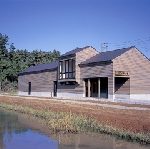
At the Historic Site Square, the earthen walls, Kenmotsu moat, built by Hori Naomasa Kenmotsu (1547 – 1608) a feudal lord, the road and the pillar building were reconstructed, based on the results of excavation investigations. Kasugayamajo Castle in the middle age was brought to mind by those.
The Kasugayamajo Castle Story Museum adjacent to the Square, introduces Uesugi Kenshin (1530 – 1578), the feudal lord of Echigo Province, and the Castle view at the time by large-screen videos. This museum exhibits the folding screen drawing Battles of Kawanakajima and other items with the videos.
You can see the ruins of Kasugayamajo Castle from the observation room on the second floor.
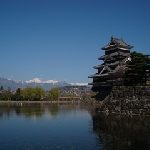
This castle was built for the Governor of Shinano Province Ogasawara clan. Ishikawa Kazumasa (1534 – 1592), a feudal lord and his son, Ishikawa Yasunaga (1554 – 1643), a feudal lord, developed this castle and the castle town, during the Azuchi-Momoyama period (1573 – 1603).
The 5-story and 6-floor castle tower built in 1593-1594 is Japan’s oldest castle wall and the national treasure castle tower. Inui Tenshu, a small castle tower in the northwest is connected to the north side of the main castle tower. Tatsumitsuke-Yagura, the turret in the southeast and Tsukimi-Yagura, the moon viewing turret are complexed to the east side of the main castle tower. Black-lacquered siding is used on the outer wall.
This castle has been standing 400 years behind the Northern Alps
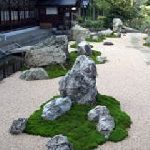
Kankoji Temple located in Minami Uonuma City, Niigata, used to be the practice place for guards of Hokuetsu: Shinshu, Sado, Noto, Echichu, and Echigo provinces during the medieval ages. Many halls of the practice palace were destroyed by the Siege of Otate, a battle between the nephew and adopted son of Uesugi Kenshin (1530 – 1578), the feudal lord of Echigo Province, over Kenshin’s inheritance.
Kankoji was restored in the Edo period (1603 – 1868), by inviting Mangen Osho, a Buddhist priest, from Kankoji Temple in Yonezawa, Fukushima, where the Uesugi family moved, and by moving the palace to the present site from the original site in the mountains. The main temple built in 1776 and the garden shows the beauty of the Zen temple in the early modern times and conveys the spirit of the medieval ages.

Sado Gold Mine, on the Tentative List of World Heritage Sites, had been mined for 388 years, since its discovery in 1601. The mine gallery extends 400 km, and was the largest gold and silver mine in Japan, with output of 78 tons of gold and 2,300 tons of silver. Doyunowareto, the V-shaped cracked trace of outcrops of the immense deposits remains, which was the beginning of the discovery of the Sado Gold Mine.
Doyukou, the mine gallery, has an operating rail car that is reserved as Industrial Heritage in modern and present days and is displayed.

Sado Gold Mine was discovered in 1601 of the Keicho era (1596 – 1615). The abundant amount of gold production supported the Tokugawa Shogunate and created the shining culture of Keicho in Kyoto. Okubo Nagayasu (1545 – 1613), a bureaucrat of the Tokugawa Shogunate, in charge of silver and gold mines, and a feudal lord, was appointed as Sado Commissioner. He set up a Commissioner’s office in Aikawa, which was a suitable place for transporting goods and building a town.
The Goto Yakusho office was the exclusive factory of Koban, a small-sized old Japanese gold coin casting firm. It was adjacent to Sado Bugyosho. Houei Koban distributed in 1710, and Shotoku Koban distributed in 1714. They have Gokuin, a stamp on the back of the gold coins, to indicate Sado production.

This temple was founded in 1497 by the Sanjo Nagao clan which was the deputy military governor of Echigo Province, Niigata. Uesugi Kenshin (1530 – 1578), the feudal lord of Echigo Province, also studied at this temple from age seven to fourteen, and the foundation of his personality was formed. The Hengaku, temple’s name tablet displayed on the gate, was hand-painted as “Daiichigi, the first principle” by Kenshin, which is stored in the Treasure hall.
There are the grave of Kenshin, and a memorial tower of the war dead in the Battles of Kawanakajima. Somon, the main gate of the temple was relocated from Kasugayamajo Castle, which is the only remains of the castle.

This castle tower was completed by Tokugawa Ieyasu (1543 – 1616), the founder of the Tokugawa Shogunate in 1612. Ieyasu let Katou Kiyomasa (1562 – 1611) build this castle’s tower stone walls with the highest technology. Kiyomasa was a feudal lord, who built Musha-gaeshi, curved stone walls in the Kumamotojo Castle.
Ieyasu also let Kobori Enshu (1579 – 1647), architect this castle tower. Enshua was a feudal lord, a master of the tea ceremony, an architect and garden designer, who designed the Sento Imperial Palace in Kyoto, Hinoki, Japanese cypress, were delivered from Kiso Mountains to Nagoya through Kuwana by making a raft of logs and sending it down the river.
This castle tower was architected to a unique Sotogata, multi-leveled tower type. It kept using those trees, which has the extreme details designed in its stability. The top of the castle tower is in the Enshu-style. It has the statue of a killer whale which is said to call for water of firebreak.
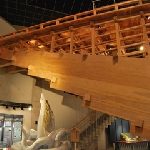
The Kurobe Gorge is a deep V-shaped gorge that rises in the upper and middle reaches of the Kurobe River, originated from Mt. Washibatake in the central part of the Northern Alps. This Gorge is listed in the top 100 unexplored regions. The trolley railroad was opened in 1937, with the development of power resources in the Gorge. Since then, it has been crowded with people who have been fascinated by the unexplored region.
In addition, the Kurobe River has a history that Maeda Tsunanori (1643 – 1724), the 4th lord of the Kaga Domain, made the Aimotobashi Bridge, which was one of the three unusual bridges in Japan. This museum exhibits part of the restored model of the Aimotobashi Bridge.
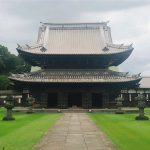
The Budhha hall of this temple was the great work of Yamagami Zenemon Yoshihiro, who was Ondaiku, a carpenter for Kaga Domain, Ishikawa. The hall worships a Buddha triad, a Buddha attended by two Bosatsus (Bodhisattvas), Monjyu Bosatsu, associated with wisdom in Mahayana Buddhism, and Fugen Bosatsu, associated with practice and meditation in Mahayana Buddhism, from the Ming Dynasty (1368 – 1644) in China. This building was made of all Keyaki, zelkova wood, which has beautiful woodgrain. This lead plate roof is the same as Kanazawajo Castle Ishikawa Gate, and this interior was built with a wooden framework structure, also like Kanazawajo Castle. This building was in the very traditional Zen-style architecture, which was complex and curious.
This temple was built as the family temple of Maeda Toshinaga (1562 – 1614), the 1st feudal lord of Kaga Domain, by Maeda Toshitsune (1594 – 1658), the 3rd feudal lord of Kaga Domain. Toshitsune’s wife was a daughter of Tokugawa Hidetada (1579 – 1632) the 2nd Shogun of the Tokugawa Shogunate, whose younger sister was Toufukumon’in Masako (1607 – 1678), a daughter of Tokugawa Hidetada, the 2nd Shogun and Chugu, (second consort of the emperor) (1625 – 1629) of the Emperor Go-Misuno. Toshitsune was familiar with the culture of the Obaku sect of Zen Buddhism, which was introduced to Japan from China during the Ming Dynasty (1368 – 1644) , in Kyoto, through Toufukumon’in.
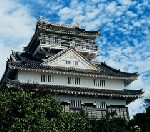
The area around Mt. Kinkazan used to be the sea, during ancient times. Mt. Kinkazan became a rocky mountain with a steep slope, due to the long-term crustal movement. An impregnable castle was built at the summit of the mountain.
Oda Nobunaga (1534 – 1582), the legendary warlord and the military dictator, captured the castle and became the lord of the castle, 1567. “Those who command Mino Province would reign over the whole country of Japan.”
There is the Nagara River underneath this castle, the source of the power of its water transportation, and the power of its economy by Rakuichi・Rakuza, free market and open guilds. In this castle, Nobunaga viewed over the figures of a modern country for the first time.
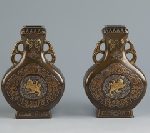
The museum systematically exhibits art and metalworks by artists deeply related to the region, as well as those who influenced local art and craftwork. Takaoka city was developed by Maeda Toshinaga (1562 – 1614), the 1st feudal lord of Kaga Domain.
Since then, the history of Takaoka culture with traditional techniques and creativity has continued. The casting developed as Takaoka copperware, and Takaoka lacquerware’s own technology has been passed down to today.
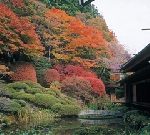
This temple is surrounded by 100 years of giant trees, has three gardens in the different styles of Zen and Daimyo, Japanese feudal lord. The stone wall following the approach has a natural treasure, Luminous Moss, which emits an emerald glow, when exposed to light, from the chloroplasts contained in its cells.
This temple was restored in the Edo period (1603 – 1868), after it suffered from disasters of the wars between the Takeda clan and the Oda clan in the Age of Provincial Wars in the 15th – 16th centuries. Luminous Moss withers during the winter and revives after cherry blossoms.
The value of this temple, with original and natural glow, like Luminous Moss, is well-preserved.
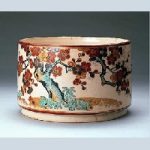
This museum is built at the site of the house of the Honda family. The Hondas were part of the Kaga Domain, a chief retainer of the Maeda family and this museum introduces a source of great culture and art of Kaga Domain.
Kanamori Sowa(1584 – 1657): a master of the tea ceremony and garden designer, who was the legitimate child of the Hida Takayama Clan and a tea master and a garden designer, introduced Nonomura Ninsei (17C) to the Kaga Domain.
Ninsei was the great potter and especially good at managing a potter’s wheel. His Kyoyaki Iroe, Kyoto style ceramic art, were earthen vessels painted with even thinness. His art was inherited by the Kaga pottery. The ultimate beauty is displayed at this museum.
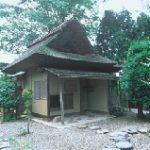
This tea-ceremony room is located on the hill, overlooking the castle tower, of Matsuejo Castle at the north lake side of Shinji Lake. This old tea-ceremony room is associated with Matsudaira Harusato Fumai (1751 – 1818), the 7th lord of Matsue Domain.
Fumai built the foundation for the development of art and culture in Matsue Domain, through the tea ceremony. This room has Shatsukei, borrowing the landscape of Shinji Lake. The view has wide open space, as if the gods and goddesses in the ancient could visit.
Fumai designed the space with the beauty from subtraction, which was the preparation for the transient beauty from near, limited space to far, open space.
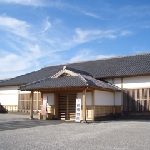
This museum introduces Hagi ware, which has less density and permeability, and more astringency as it is used, due to it being made in a kiln at low heat. Hagi ware began when the Mouri clan moved to Hagi from Hiroshima after the Battle of Sekigahara in 1600.
Hagi ware used to be similar to the process and shape of Korai Chawan, bowls from Korea. Hagi ware developed the permeated tint and the dispassionate taste during 400 years, like Horiuchi’s streetscape in the Castle Town of the Mouri clan.
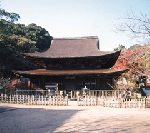
This temple was founded in 1320, which was the place of standing up against Tokugawa Shogunate party by Takasugi Shinsaku (1839 – 1867), a samurai from Choshu Domain of Japan who contributed significantly to the Meiji Restoration.
This temple was built in the traditional Chinese-style architecture, which was the traditional Zen-style architecture in the Kamakura period (1185 – 1333). This roof is in the Irimoya Zukuri style, with a hip-and-gable roof structure and Hiwadabuki, cypress bark roof, which is masterly curved and suppressed for stability.
This temple has Hengaku, the temple’s name tablet displayed on the gate, of Kinzan which was an Imperial scroll, written by Emperor Go-Daigo (1288 – 1339), who successfully overthrew the Kamakura shogunate and brought the Imperial House back into power (1333 – 1336). The Ashikaga shogunate split the imperial family into two opposing factions between the Ashikaga backed Northern Court situated in Kyoto and the Southern Court based in Yoshino Nara led by Go-Daigo and his later successors.
This principal image of Buddha is a seated statue of Senju Kannon, the Buddhist Goddess of Mercy with 1000 arms, which was Yosegi zukuri, the technique of assembling wood blocks, treated and carved, made of cypress wood. The tails of this statue’s eyes are raised up, and its lips are pressed. Its face is noble. The statue is realistic, which is typical in the end of the Kamakura period (1185 – 1333). It is said that the statue was made by Unkei, a sculptor of Buddhist statues in Kyoto.
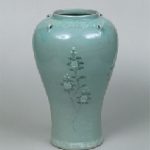
The museum introduces Hagi ware and related pottery works with a history of 400 years, and possesses Ukiyoe, Japanese woodblock prints, and Oriental ceramics, as the core of the collection. These pieces were donated by Mr. Uragami, who came from Hagi.
This museum possesses Seijizougan Kikamon shijiko (Inlaid celadon porcelain jar with Chrysanthemum pattern and four lug handles). Its Tachigiku pattern, a standing-chrysanthemum pattern, which was inlaid with black, is very subtle. A leaf pattern at its top and thunder pattern at its body are decorated with white inlay.
This body is a style of earthenware pot with a squared shoulder and slender waist. This inlaid celadon porcelain is elaborate and splendid, which was made during the Goryeo Period in Korea, in the 12th century.
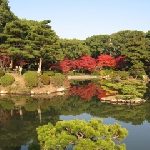
This garden was created by Asano Nagaakira (1586 – 1632), a 1st lord of Hroshima Domain, as a separate residence garden from 1620. This garden was landscaped by Ueda Soko (1563 – 1650), the chamberlain of the Hiroshima Domain and the founder of the Ueda Soko school for the Japanese tea ceremony. Soko gathered a number of scenic spots in his designs, including a small version of Sai Lake in Sung China.
Shukkeien, in Japanese, means “reduced scenic garden.” This Japanese tradition builds from the finest, elaborate architecture and art. It is fully demonstrated at this garden.
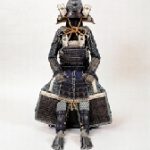
This museum conveys the history of the last completed castle in the Edo period (1603 – 1868) and Daimyo, Japanese feudal lords Culture, in the early modern times. It possesses old drawings, a small dining table with the family crest, bowls and Fushimi Palace sliding screen board painting.
This museum also introduces the primeval and ancient history of Fukuyama, and exhibits clay ware from the Jomon period (16,000 years ago – 3,000 years ago) and the Yayoi period (the 4th BC – 3rd century), stoneware, bronze swords, Haniwa, clay images from the Tumulus period (the 3rd– 7th century), gems, old roof-tiles, and Sue ware, unglazed vessel, earthenware.
This museum also introduces the history of Fukuyama as an important place of the Seto Inland Seaway, through which the civilization and culture from the China continent and the Korean peninsula, had advanced to the east.
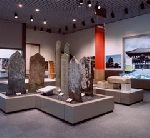
The Hachisuka clan entered Awa Province Tokushima from Tatsuno Harima Province Hyoto, after the Shikoku Conquest in 1585 by Toyotomi Hideyoshi (1537 – 1598), the powerful feudal lord and Imperial Regent who unified Japan. They established the economy by monopolizing special products. Ai, indigo produced in the Yoshino River basin were shipped nationwide as an Aidama, an indigo ball to be used as a dye.
Nigyo Joruri, a Japanese puppet show, was created at Nishinomiya Shrine, incorporated with Shamisen, a three-stringed Japanese lute in Ryukyu Province, Okinawa. It was spread to Awajishima Island, supported by the economic power of the Hachisuka clan and merchants of indigo.
Nigyo Joruri grew to be a powerful acting style in Awa Province Tokushima.

The museum possesses approximately 12,000 items, including hanging scrolls, folding screens, drawn by modern poets, Japanese traditional poetry, old documents, painters, calligraphers, experts in the tea ceremony, monks, Busho (military commander), politicians, and literary men, from the Heian period (794 – 1185) to modern days.
This museum exhibits those and also holds special exhibitions of modern art. This folding screen was drawn by Tosa Mitsuoki (1617 – 1691), a Japanese painter and head of the Tosa school in Yamato-e. Mitsuoki revived the Tosa school with the size and decoration of the early modern scale.
The appearance of Kono Michinobu (1522 – 1581), the 38th head of the Kono clan in the participating war, as the Minamoto’s army was reproduced with the refinement of the early modern times, by Mitsuoki
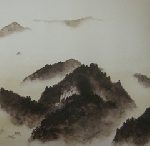
This museum possesses works of Yokoyama Taikan (1868 – 1958), Munakata Shiko (1903 – 1975), a Japanese woodblock printmaker, which adorn the history of Japanese modern art, in addition to books of Rai Sanyo (1781 – 1832), a Japanese Confucian scholar, historian and Imperialist who influenced emperor-centered nationalism at the end of the Tokugawa Shogunate, in the latter part of the Edo period.
Sanyo thought the Unity of Shintoism and Confucianism, the systems of prayer in Japan, since ancient times, and the idea of Jin, benevolence, were virtues. In the 19th century, he wrote Nihon Gaishi, a book of Japanese samurai’s history, from the Heike (Taira) clan to the Tokugawa family, and influenced the movement of Sonno Joi, the emperor-centered nationalism and the expulsion of foreigners.
His insight foresaw the modern days coming which understood the historical turning point, as Ikioi kiwamareba sunawachi henzu, (When the momentum becomes extreme, things will change), and Henzureba sunawachi naru, (When things change, transformation will occur).

—This museum is currently closed due to renovation work, and is scheduled to be reopened in about the fall of 2022.
This museum exhibits the cultural heritage of Okayama Prefecture from the primitive and ancient times to the modern era in an easy-to-understand manner. Kibi Province Okayama had advanced their culture since ancient times, along with Northern Kyushu region and Kinai region, provinces surrounding Kyoto and Nara.
The history of swordsmith had been handed over along the Yoshii River, which used to transport Tamahagane, steel made from iron sand, and wood for fire, to make the swords.
Osafune school in Bizen had produced many famous swords since the Kamakura period (1185 – 1333), and samurai had longed for them, due to their long length and forging.
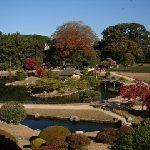
The artificial hill in this garden, Yuishinzan, was made in front of Enyoutei, the living room of the feudal lord, with the measured distance from time and position of rural scenery above Mt.Misaoyama. The rural scenery was also overlapped with a meandering stream landscape in front of Enyoutei. Everything in the landscape was measured well in order to enjoy the view.
Since ancient times, Japanese have been awe-inspired by nature. The beauty of Samurai, used the power of nature to live and survive. This garden overlooking Okayama Castle is a theme park of a Japanese garden, and river earthen walls to protect the castle, too.
Everything was measured and thought well.
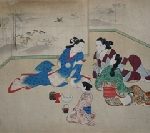
Miyagawa Choshun(1682-1752), the Japanese painter, drew charming and dignified women in his original paintings. He specialized in silk painting and did not paint woodblock print, by supported by influential people. He adored Hikawa Moronobu (1618 – 1694) a Japanese artist of the ukiyo-e genre of woodblock prints. He drew a dignified beauty who did not lose the stability of verticality even if she leaned up while standing.
The museum possesses the incisive masterpieces of the Hachisuka family, who survived the war, and the collection of folk-like paintings of beautiful spots in Edo by Miyagawa Isho (1689 -1780), Japanese painter, who was a disciple of Choshun.
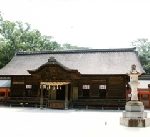
This shrine possesses and exhibits the masterpieces of the end of the Heian period in the 12th century. Konito Odoshi Yoroi, Armor with navy blue lacing, with Osode, large sleeves and a war helmet, was dedicated by Kouno Michinobu (1156 – 1222) warlord of a powerful clan in Iyo Province.
The enshrined deity, Oyamatsumi no mikoto, a god of mountains, sea and war in Japanese mythology, had been worshiped by successive imperial courts and warriors.
There are 8 national treasures and 75 national important cultural properties in their dedication treasure. This shrine is the Samurai Beauty Hall of Fame.
Hitori Sumo, the act of mimicking two people sumo wrestling, to pray for a good crop on May 5th and the Nuibo-sai Festival, a rice-harvesting ceremony on September 9th are held according to the Japanese lunar calendar since ancient times.
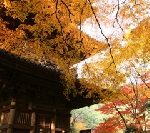
This temple, is located 100-300m above sea level at the eastern foot of the Takanawa Mountains in Ehime Prefecture. It is famous for its autumn colors. The highlights of this temple are – the main temple of a hip-roofed building in Setchu-yo, a mix of Japanese-style and Zen-style architecture. Hokyoin-to, a Buddhist pagoda used as a tomb and memorial tower, enshrined Hokyo-kyo, a sutra roll for expiation and long life. The sutra roll spread among samurai families after the Kamakura period (1185 – 1333), and the three-storied pagoda spread in the latter part of the Edo period (1603 – 1868).
Those highlights represent the level of faith that was inherited from Minamoto no Yoritomo (1147 – 1199), the 1st shogun of the Kamakura Shogunate, the marine force of the Kono family in the Medieval Ages, to the Matsuyama Domain in the early modern times.
Those are deeply overlapped in the nature of the mountains and the precincts.
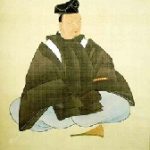
This museum is built on the site of the residence of the Rai family. It exhibits the deposits of the Takehara Rai family and Shunpukan, the residence of the uncle of Rai Sanyo (1781 – 1832), a Japanese Confucian scholar, historian and Imperialist who influenced the rise of emperor-centered nationalism at the end of the Tokugawa Shogunate period.
Sanyo wrote the introduction of Sangokushi-engi, Romance of the Three Kingdoms in the 2nd -3rd centuries in China, which was published as a “Picture book in popular style, Sangokushi-engi” in 1835.
He mentioned that the trend of present days became unfamiliar with Keigi, the understanding of classic Confucian writings. He felt the present poetry and prose became old fashioned and the present books became sleepy. Under the situation, I prefer to read Sangokushi-engi, which elegantly depicted the evil spirits.

This garden is a Daimyo Teien, gardens of Japanese feudal lords, with four large and small islands floating in a pond, which was landscaped by Kobori Enshu (1579 – 1647), a feudal lord, a master of the tea ceremony, an architect and garden designer. It imitated the Sento Imperial Palace in Kyoto.
This used to be a Reception Hall, where the lord met the retainers and envoys of other Domains. It was also the retreat of the lord. Therefore, it has Kirei sabi, rich beauty and refined simplicity, with characteristics of feeling free by adding motif and designs everywhere.
It is reminiscent of the Japanese understanding that prayer is for climate and nature, and harmony shifts with those.

This garden was made in 1668 by the Kyogoku clan, which was the feudal lord of the Marugame Domain. It has Matsubara, a beautiful scenic stretch along a sandy seashore, dotted with pine trees. It also has Hakkei-ike, a pond from Biwa Lake in Omi Shiga, and eight islands in the pond from Omi Hakkei, Eight Views of Omi. Omi was the place where the Kyogoku clan came from.
The Japanese had accepted Aware, the sorrow from understanding that harmony shifts with climate and nature, and places the beauty of the senses on those. This garden delivers the beauty of the senses.
It has its own theme that everything in the universe, and the universe is inside the garden. It is very magnanimous in its attitude of the mind. This museum exhibits Western paintings by masters such as Jean-Francois Millet (1814 – 1875), the French painter and one of the founders of the Barbizon school, and Henri Rousseau (1844 – 1910), a French primitive painter.
That is a fusion beauty and wisdom.
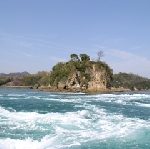
This museum is located on Oshima island on the Shimanami Kaido, 60 km long toll road that connects Japan’s main island of Honshu to the island of Shikoku, passing over six small islands in the Seto Inland Sea. The Noshima Murakami clan was the family of Murakami Ancient Navy.
This museum preserves materials and books of the Noshima Murakami clan, which had the mastery of the Seto Inland Sea in the Age of the Provincial Wars in the 15th – 16th centuries, gained wealth from sea trading.
This museum introduces Noshima Mare, which was the secret of the Seto Inland Sea. And the boat to experience the tidal current, sails from the front of this museum. You can feel the dynamism of Murakami Takeyoshi (1533 – 1604), naval commander, head of the Noshima Murakami Ancient Navy.
He fought for maintaining the mastery of the sea and also held Utakai, a poetry competition.
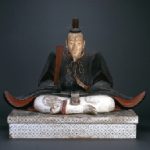
A Kokubunji, a state-supported provincial temple in the 8th century has thick woods in the grand rural districts. Mt. Okoyama (97m) is overlooking it.
There is the site of Chosokabe clan’s Castle in the Age of Provincial Wars in the 15th – 16th centuries, from which you can overlook the Kokubu River flowing below the hillsides facing south and the wet paddy extending from west to south.
This museum stands on the hillside of the Okoyamajo Castle’s site, which exhibits a sedentary statue of Chosokabe Motochika (1539 – 1599), a feudal lord, the 21st head of the Chosokabe clan in Tosa Province, and features the real figure of Motochika.
He was born and had grown up in this castle. And he approached the mission impossible to complete the unification of the Shikoku region, from this castle.
*It is currently closed until mid-April 2021, due to the renovation work.

Ikeda Mitsumasa (1609 – 1682), a feudal lord and the 1st lord of the Okayama Domain, founded this school for the education of common people, in 1670. Its lecture hall is a National Treasure. Its sacred mausoleum and Shizutani shrine are important cultural properties. All of its roofing tiles used Bizen ware, Bizen Province, Okayama.
The neo-Confucianism and the porcelain brought to Japan in the Japanese invasion of Korea (1592 – 1598) by Toyotomi Hideyoshi (1537 – 1598), the powerful feudal lord and Imperial Regent who unified Japan, in the Azuchi-Momoyama period (1573 – 1603), spread to common people in the Edo period (1603 – 1868).
And the history of those days, when each feudal domain competed for the education of local clans, has been preserved here.

This garden is Daimyo Teien, gardens of Japanese feudal lords during the Edo period in the 17th -19th century, which benefits from the scenery of Mt. Shiunzan. The foundation of this garden was made by planting around Nanko Lake, in the period of the 4th lord of Sanuki Domain, Ikoma Takatoshi (1611 – 1659).
The garden was refined by the grandson of Tokugawa Ieyasu (1543 – 1616), the founder of the Tokugawa Shogunate, Matsudaira Yorishige (1622 – 1695), a feudal lord, the son of the first lord of the Mito Domain, the elder brother of Tokugawa Mitsukuni, and his descendant of the Matsudaira clan over the span of 110 years.
The name of this garden, Ritsurin, means Chestnut trees which also meant an undeveloped woodland near populated area, in China. But 1,400 pieces of evergreen pine trees instead of Chestnut trees are planted in this garden with stones and water which create the scene of the ultimate garden.
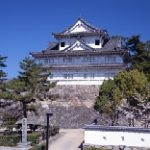
Fukuyamajo Castle was built by Mizuno Katsunari (1564 – 1651), a feudal load, a general of the Tokugawa Shogunate, as a base for the protection of the western part of Japan, to the Tokugawa Shogunate. This castle has a splendid appearance with 3-stories of white walls and is the last completed fine castle in the Edo period. Japanese have been awe-inspired by nature since ancient times.
The beauty of the Samurai took the passage of the nature and made it a power to live. The preserved early modern castle tells us of the Tokugawa Shogunate’s strategy to create beautiful scenery as a symbol and the admirability of the early modern Daimyo, feudal lord, culture.
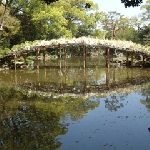
This garden site used to the part of Hama Goten, palace, which was made by reclaiming land in the sea. Date Munetada (1792 – 1889), the 7th castle lord of Uwajima domain, made this garden at the site in 1868, which has Shatsukei, borrowing the landscape of Onigajyo Mountains This garden is a Japanese style garden with a path around a central pond. Date family ancestors were the Fujiwara clan, a powerful family of regents in Japan. Their family crest is wisteria. By that connection, many wisterias were planted at this garden.
This garden’s name came from the poem of Date Masamune (1567 – 1636), a Japanese feudal lord, the founder and the first lord of the Sendai Domain, which was made later in his life. That poem says “Without enjoying, what should we do in the life. The remnants of my life will depend on the forgiveness by heaven” Tensha means forgiveness by heaven.
The year this garden was made, 1868, was the End of the Edo period. Through this garden, you can see the resolution of the intellectual lord with insight at the end of the Tokugawa period.
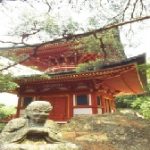
This temple was established in 1397 by Guchu Shukyu (1323 – 1409), a priest of the Rinzai sect, who went to study in the Yuan Dynasty (1279 – 1368). Guchu studied in Kyoto under Musou Soseki (1275 – 1351), a Rinzai Zen Buddhist monk and Kokushi, national Zen teacher.
He went to China by Tenryuji bune, trading vessels dispatched to the Yuan Dynasty (1279 – 1368) in order to raise funds to build Trenryuji Temple, a structure planned by Soseki, in the period of the Northern and Southern Courts (1336 – 1392). At age 75, Guchu came to Aki Province Hiroshima, in order to open the greatest pure Zen practice place in Japan and servicing for Tenneiji Temple in Kyoto.
Kyomokyo bridge, where it is said that big snake appears and threatens imprudent person to cross, is a spiritual cleansing barrier of this temple. The mountain stream under this bridge is called Katsuryu River, the river of resuscitation. In the fresh green season, Aomomiji, green maple, maple trees not yet turned red, fills the bodies of people who cross the bridge. Please enjoy bliss.
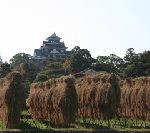
-This castle will be closed from June 1, 2021 to about the fall of 2022 due to a large-scale renovation. During this construction, Ujo Park (excluding Ishiyama Park) will also be restricted from entering.
Okayamajo Castle is a jet-black Kinujo Castle, a sacred bird of castle. This castle was built under the guidance of Toyotomi Hideyoshi (1537 – 1598), the powerful feudal lord and Imperial Regent who unified Japan, and was completed during the days of the Ikeda feudal lord under the Tokugawa Shogunate in the Edo period (1603 – 1868).
This castle shines on the surface of the river. Okayama Koraku-en, one of the Three Great Gardens of Japan, along with Kenroku-en, and Kairaku-en, surrounds like earthen walls, the opposite bank in the northeast of Honmaru, the keep of a castle. Okayama Koraku-en was made in the Edo period.
Originally Hideyoshi built a castle in this area in order to protect Kyoto and Osaka from the Mouri clan, the great feudal lord in the western part of Japan. Therefore, there is no defense palisade in the east of the castle. It is the admirability of the huge garden that has the meaning of extending the ranges of bow’s and arrow’s shot and gunshot to the castle.
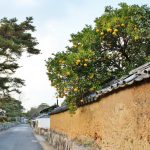
Hagi ware was made with kilns of this Domain. Production started with Korai Chawan, bowls, by inviting potters of brother Ri Shyako, and Ri Kei from Korea. Hagi ware became famous as one of the highest rankings for Japanese antique tea bowls. The highest ranking is Raku Ichi (named after Raku ware). The Second highest ranking is Hagi Ni (named after Hagi ware) and the Third highest is Karatsu San (after Karatsu ware). There are still many potteries here, with a tradition more than 400 years.
Horiuchi district is located around the former Hagijo Castle, third bailey. The castle was built at the foot of Mt. Shizukiyama in 1604, after a 4 year construction period, by Mouri Terumoto (1533 – 1625), who had extended his clan’s power to nearly all of the Chugoku region. Terumoto was a feudal load, and grand son and successor of Mouri Motonari (1497 – 1571) a feudal lord in the western Chugoku region of Japan.
Horiuchi started from the layout of the castle town by Terumoto, which was organized during the Castle construction. There used to be various government offices of the Domain and the residences of high ranking samurai, including a family of the Mouri clan.
The zoning of the residences of the samurai in the castle town of the early modern times still remains. This includes the historical urban district, with Chinese citron seen over the stone walls and mud walls.
lls.
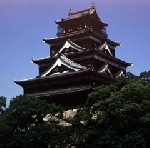
The Ota River estuary is a cove with small islands and sandbars. Due to the convenient transportation of water and land, Mouri Terumoto (1533 – 1625) a feudal load, grand son and successor of Mouri Motonari (1497 – 1571) feudal lord in the western Chugoku region of Japan, extended his clan’s power to nearly all of the Chugoku region, built Hiroshimajo Castle in 1589.
The construction of this castle was a large-scale building including stone walls, moats, and a castle tower, and a castle town was also built.
Although there were no actual battles against this castle, it was only a quirk of history that this castle became the front-line base of the Shogunate army during the Second Subjugation of Choshu, Mouri clan in 1866.
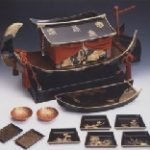
Goto Tamekiyo (1553 – 1583), who was a retainer of Yamanouchi Kazutoyo (1545/1546 – 1605), a feudal loard, first lord of Tosa Domain, drew an arrow from the face of Kazutoyo by putting his foot on Waraji, straw sandals, and stamping down on the face, in the field of battle.
His family served the chamberlain of the Tosa Domain, built their residence at the site of Akijo Castle and let their retainers live around it, in the Edo period (1603 – 1868).
That is Doikachu, the area of samurai residences, where hedge of Obame Kashi, Japanese oak, continued and the elegant appearance exists. This museum introduces the elegance of the Goto family through traditional armors, arts and crafts, too.

This museum which was built the site of the Akizuki clan school, Keikokan, which gave scholarly lectures and the martial arts, took over the collection of the Akizuki Folk Museum and opened in 2017. The balance of this collection between the Japanese and Western collections is excellent, and the exhibition is surrounded by the beauty of insight.
The collection of about 100 items, consists of feudal lord’s favorite helmet, armor, famous sword, battle surcoat, horse armor, folding screen, and Akizuki historic documents, books, portraits, and others.
This museum also has works of Pierre-Auguste Renoir (1841 – 1919), Marc Chagall (1887 – 1985), Yokoyama Taikan (1868 – 1958), Kawai Gyokudo (1873 – 1957),and Uemura Shoen (1875 – 1949), which were donated by Toki clan from Akizuki.
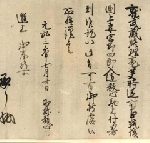
This temple was the starting point of Ashikaga Takauji (1305 – 1358), the founder of the Ashikaga Shogunate. He became a supreme ruler, with rousing himself again, after he defeated and fled from Kyoto, in the period of the Northern and Southern Courts (1336 – 1392).
The brother of Takauji and Ashikaga Tadayoshi (1306 – 1352), a general, built Ankokuji Temple and Rishou-to Pargodas to perform the salvation of the departed soul of Emperor Go-Daigo (1288 – 1339) and the emperor’s retainers, across the Provinces of Japan.
They aimed to heal the hearts of the devastated country and people by the battles in the the Northern and Southern Courts, at the suggestion of Musou Soseki (1275 – 1351), Rinzai Zen Buddhist monk and Kokushi, national Zen teacher.
This temple remains the oldest Kishinjo, the letter of donations, about Ankokuji Temple and Rishou-to Pargodas, in Japan, which came from Tadayoshi. This temple makes a harmony with the plains at the foot of Mt. Fukuchiyama.
It evokes the atmosphere of the period of the Northern and Southern Courts, which had elegance and rural beauty.
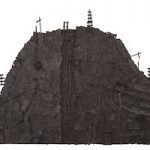
This museum possesses a lot of works by artists who are well associated with Tagawa City, as well as Agano ware, traditional porcelain of Fukuoka prefecture. Hosokawa Tadaoki (1563 – 1646), a feudal lord, the eldest son of Hosokawa Fujitaka Yusai, invited a Koraen potter, Sonkai (Japanese name, Agano Kizo) (1566 – 1654), and he built a climbing kiln in the Edo period (1603 – 1868), when he was the lord of the Kokura Domain. It was the beginning of Agano ware.
Tadaoki was one of Rikyu shichitetsu, the seven disciples of Sen no Rikyu(1522 – 1591),the greatest tea master, and the tea master to the military dictator of Japan, Oda Nobunaga. Toyotomi Hideyoshi invented the wabi-sabi style of tea ceremony, and was mostly admired by Rikyu. The green ware of Agano is thin and light.
It is used with many types of glaze, which changes its pattern in the kiln. It is without ceramics painting. It is the beauty of Samurai.

This museum located in Tenjin, the central area of Fukuoka City, introduces painting materials of the Ogata family. Goyo-eshi, a purveying painter to the Fukuoka Domain, and Yoshimura Tadao (1898 – 1952), a Japanese painter, who learned from Matsuoka Eikyu (1881 – 1938), painted in the style of Yamato-e, and the works of Yamato-e, to express high realism and decorativeness, with subdued color and a depth of taste.
This museum possesses arts associated with Fukuoka Prefecture, like Kurume Kasuri, cotton cloth with splashed patterns, and antique porcelains from the Kyushu area. And the art scene of Fukuoka’s “now” is also introduced.

This temple faces the Kuma River and has the original style architecture combined with the splendid decoration of the Azuchi-Momoyama period (1573 – 1603) and the strong uniqueness of the Kuma region, which had been built for four years since 1609. The roof ridge is high and the slope is steep. The roofing is made of grass.
All of the shrine buildings are black-lacquered at their base, the details of the wooden structure are vermilion-lacquered and the sculpture and design patterns are richly colored. These architectures and designs are the true value of the lord of the Domain, the Sagara family, which had a 700 year history, since the Muromachi Period (1366 – 1573).
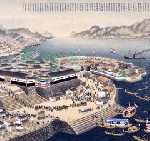
This castle is the castle of Nabeshima clan of Saga Domain. The Saga Castle History Museum, which has faithfully restored part of the palace of Honmaru, the keep of a castle, is now built on the site of Saga Castle. A 45m long hallway with tatami-matted floors and a large hall with 320 tatami mat salon convey the dignity and formality of the palace of Honmaru.
This museum introduces the sprits of the Nabeshima clan with the clan kiln of Nabeshima ware, to create traditional beauty of style and the passion of the Nabeshima clan. The painting of Nagasaki Naval Training established in 1855, tells the history of the End of the Edo period, in the 19th century, to explore the civilization from abroad.
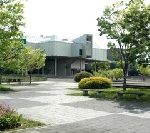
This museum introduces the history of Saga, the source of many people who have built a modern education system such as Okuma Shigenobu (1838 – 1922), Prime minister of Japan, and the founder of Waseda University, and Oki Takato (1832 – 1899), a Japanese statesman and Governor of Tokyo. This museum exhibits 1,208 objects and fully introduces the history of this prefecture, where many things began in Japan.
The plain area in the southern part of Saga city was under the sea, during the Jomon period (16,000 years ago – 3,000 years ago) and the Yayoi period (the 4th BC – 3rd century). The ritual, the courtesy of welcoming honored guests of the Chinese Dynasty, castle structure, and calendar, etc., had come to the hillock near the sea side, and were taken into the root of this country.

This museum exhibits some 90 rare old guns from the world, including the first Hinawajyu, matchlock gun that arrived in Japan from Portugal. This museum guides well the history of Tatara, an iron manufacturing method that uses iron sand, in Tanegashima Island, used for the domestic production of Hinawajyu.
This museum explains the relations with Sakai-shu, the merchants who organized self-governance in Sakai in the Muromachi Period (1366 – 1573). In the Kinai region, provinces surrounding Kyoto, Nara, and Negoroshu, a group of monk warriors based in Negoroji temple, Ki Province, made Zaigabachi, a helmet for Saikashu, a group of trading warriors from around the mouth of the Kinokawa River Ki Province.
You understand well the overlapped way of the Kuroshio, the Japan Current and guns, and the speed of changing history.
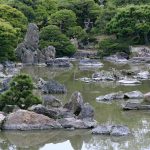
A Japanese-style restaurant with an attached inn, Ohana was built in 1738 as the villa of the Tachibana clan, a feudal lord of Yanagawa Domain. At present, you can visit the gardens, Shotoen and historical museums as tourist facilities. The museum exhibits the helmet and armor worn by Tachibana Muneshige (1567 – 1643) , a feudal lord, the 1st lord of the Yanagawa Domain.
There is also Tachibana clan’s Daimyodougu, Japanese feudal lord’s, belongings. Muneshige participated in the West Squad in the Battle of Sekigahara in 1600 in order to repay Toyotomi Hideyoshi’s favour, whether it won or lost. He was defeated and his domain was confiscated.
However, he was the only defeated feudal lord who came back to his previous Domain in the Age of Provincial Wars in the 15th – 16th centuries, after the Battle of Sekigahara.
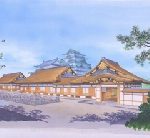
Nagoya in Hizen Province, Saga was the base of the Bunroku-Keicho War (1592 – 1598), the Japanese invasion of Korea. Nagoyajo Castle was built as the abode of Toyotomi Hideyoshi (1537 – 1598), the powerful feudal lord and Imperial Regent who unified Japan. Toyotomi built encampments for feudal lords all over Japan to participate in the war. Momoyama culture, whose splendid style began in Kyoto, started to spread all over Japan from here. This museum introduces its history.
This museum possesses the folding screen painted by, Kanou Mitsunobu (1565 – 1608), the eldest son of Kanou Eitoku, (1543 – 1590), one of the most influential Japanese painters, and a head of the Kanou school of Japanese painting. Kanou Eitoku painted in magnificent style. Kanou Mitsunobu painted delicate, elegant and gentle lightness to express the profoundness of the subject, even when criticizing himself, in comparison to his father.

The Former residence of Hosokawa Gyobu family is currently closed due to the Kumamoto earthquake in 2016. The residence has the formality as the residence of a high ranking samurai. It has Gogenkan, the front entrance, with a Karahafu-style cusped gable, Onkyakuma, a drawing room, Omote Shoin, a reception hall, with the cloister. The main building is connected Shunshokaku with 2 stories, drawing room. The separate building has Kanseitei, a tea-ceremony room, and a drawing room of Japanese style. Another one is Gohozo, a treasure house. The Hosokawa Gyobu family, started from Hosokawa Okitaka, who was Hosokawa Tadaoki’s fifth son, and the younger brother of Hosokawa Tadatoshi (1586 – 1641), the first lord of Higo Domain. The family had been supporting the great clan for a long time, serving the lord. The aesthetics of life appears in the stone pavement in front of this residence.
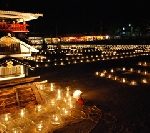
This town, Takanabe had the relation with the Six Dynasty periods in China, in the 3rd-6th centuries, by the excavation of Shishin Shinju Kyo, an ancient mirror decorated with four gods and four divine beasts.
The Akizuki clan, who is said to be the descendant of the Chinese Emperor of the Han Dynasty, moved here from Chikuzen Province Fukuoka, Kyushu. After the conquest of Toyotomi Hideyoshi (1537 – 1598), the powerful feudal lord and Imperial Regent who unified Japan, Takanabe flourished as a castle town of the Akizuki clan with 30,000 koku, a unit of volume of rice, in early modern times.
Akizuki Taneshige (1744 – 1819), the 7th lord of the domain founded a clan school, Meirindo, in the golden age of this domain. The lantern festival, in which lights shows learning in the dark is held in October, to remember the illustrious memory of Taneshige.

Japanese have been awe-inspired by nature since ancient times. The beauty of theSamurai took the passage of the nature and made it a power to live. Tsuyamajo Castlegoverned the important place since ancient of the Izumo main road that connects the Kinai region, provinces surrounding Kyoto and Nara.
The biggest turret of this castle is Bicchu Yagura, the turret with 2 floors and living space for the feudal lord in the southeast of the site of the Castle Tower. It also has a tatami-floored room in the Palace style.
The preserved and handed down modern castle tells us of the Tokugawa Shogunate’s strategy to create beautiful scenery as a symbol and the admirability of the early modern Daimyo, feudal lord, culture.
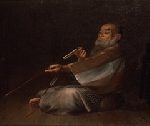
This museum was opened in 1983 on the site of Sagajo Castle, third bailey, for the 100th anniversary of the prefectural government.
This museum possesses many masterpieces of artists from Saga. This museum exhibits Modern Western paintings of Hyakutake Kaneyuki (1842 – 1884) a diplomat and a Japanese painter, who studied painting in France, Kume Keiichiro (1866 – 1934), a Japanese painter, who learned from French painter Raphael Collin, Okada Saburosuke (1869 – 1939), a Japanese painter, sculptures by Koga Tadao (1903 – 1979), a Japanese modern and contemporary sculptor, calligraphy of Nakabayashi Gochiku (1827 – 1913), one of the best Japanese calligraphers in the Meiji period (1868 – 1912), Soejima Taneomi Sokai (1828 – 1905), a diplomat, Japanese calligraphers, and others.
Above all, you should see Hizen-to, the sword of Hisen Province, Saga, founded by Dadayoshi (1572 – 1632), the originator of Hizen-to. Dadayoshi was the master of Hizen Shito, a new sword from Hizen Province. Hizen-to fully conveys the Nabeshima clan‘s intelligence about beauty, as these swords do not lose their color.
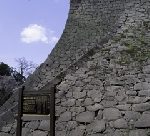
Kumamoto Castle which was greatly damaged by the great earthquake in 2016, currently aims to complete its restoration.
This castle built on the hillock of Mt. Chausuyama is one of the three great castles in Japan. The castle was built by Katou Kiyomasa (1562 – 1611), a master in castle walls in early modern times and a feudal lord. His style was magnificent and elegant.
This castle wall showed his determination to fight Tokugawa Ieyasu (1543 – 1616), the founder of the Tokugawa Shogunate, after the Battle of Sekigahara in 1600. The mason who built this castle was the same mason who built the Meganebashi, a two-arched bridge at Kurokawa, Aso province Kumamoto. Musha-gaeshi, curved stone walls at this castle was to be carved away inside for sustaining flushness. The arch of the bridge was made by extending the curve of Musha-gaeshi to the limit.

Suizenji Temple used to be located by an underground spring that brought water from Mt. Aso. The Hosokawa family made Daimyo Teien, gardens of Japanese feudal lords, around the spring pond, which is a Japanese style garden, with a path around a central pond, from the Azuchi-Momoyama period (1573 – 1603). Each place in the garden resembled the famous spots of Tokaido, the route connecting Kyoto and Edo, Tokyo’s name in the Edo period.
Hosokawa Fujitaka Yusai (1534 – 1610) the founder of the Hosokawa family in early modern times, did Kokin denju, the initiation about the interpretation of Kokin Waka shu, the Imperial anthology in the 10th century, to Prince Toshihito. The Prince was the grandson of Emperor Ogimachi (1517 – 1593) and the founder of the Katsuranomiya family, and built Katsura Rikyu Imperial Villa, at Kokin denju no ma, the reception hall.
The Kokin denju no ma was relocated here from Kyoto Imperial Gardens.
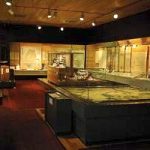
Takanabe history comprehensive museum is located in the Maizuru Park of Takanabejo (Akizukijo) Castle ruins. This museum introduces the relation with the Six Dynasties period in China, in the 3rd-6th centuries, by the excavation of Shishin Shinju Kyo, an ancient mirror decorated with four gods and four divine beasts.
This museum also introduces Akizuki Tanetatsu (1833 – 1904), the son of the 9th lord of the Tanabe Domain, who studied under Yasui Sokken (1799 – 1876), a classical scholar of Confucianism. He was appointed the magistrate of Gakumonjo, the prestigious school in the Tokugawa shogunate and it was said that he lectured Emperor Meiji (1852 – 1912), later. Banzaitei, which was the restored residence of Tanetatsu, has Suikinkutsu, a water harp.
The sound of Suikinkutsu clears up at the house.
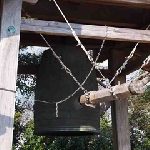
Nobeokajo Castle was built by Takahashi Mototane (1571 – 1614) a feudal lord, in 1603. The bell tower in the site of the castle tower still tells time. This castle was the early modern style which had Honmaru, the keep of a castle, Ninomaru, the second bailey and Sannomaru, the third bailey.The 22m-high stone wall was designed to prevent enemies entering from Ninomaru to Honmaru.
It is said to be designed to break down the stone wall when the cornerstone was removed. The noh theater performed at night by a fire, a unique thing in Nobeoka, is held in front of this stone wall in October. There are visitors from all over the country.
